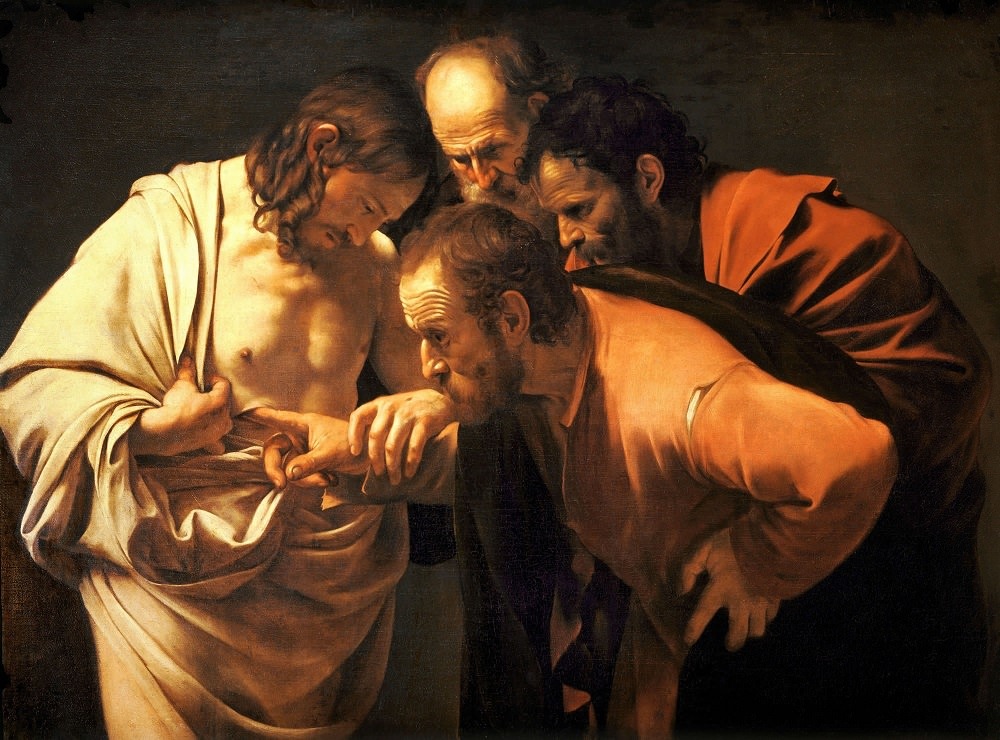This reflection is based on John 20:19-31.
In our Lord’s resurrection appearances, all his closest friends and followers seem to have a hard time recognizing him. Either his risen body looks different or the eyes of his disciples have been at least initially veiled.

Mary Magdalene mistakes him for a gardener whom she suspects of spiriting her Master’s body away from its tomb–that is, until he calls her by name in a tone that has always belonged only to him.
For the two disciples traveling to Emmaus, he is just another stranger on the road, albeit unusually knowledgeable in scripture–that is, until he breaks bread with them at supper.
And finally, for the disciples at the Sea of Tiberias, he is just some random bystander inquiring about their rusty return to fishing–that is, until they get another miraculous catch of fish.
For someone who doesn’t seem to look a lot like his pre-Easter self, the Risen Christ has a pretty roundabout way of identifying himself. I mean, what’s wrong with “Hi, I’m Jesus!”?
Today’s Gospel story is no exception. When the disciples tell Thomas that he has just missed their surprise reunion with Jesus in that same room of their last supper together, the doubting disciple sets his condition for believing:
“Unless I see the mark of the nails in his hands
and put my finger into the nailmarks
and put my hand into his side, I will not believe.”
With those words Thomas earns his title as the patron saint not only of people who ask questions about the faith, but also of those who require tangible proof before believing. In other words, doubters and positivists.

When the Lord makes another appearance one week later, Thomas is present. This time Jesus identifies himself through his wounds: Not only does he let Thomas see the wounds he has demanded to see, but he also invites him to touch them.
“Do not be unbelieving,” Jesus tells him, “but believe!”
Thomas professes his faith, crying out in astonishment, “My Lord and my God!” But Jesus tells him, “Have you come to believe because you have seen me? Blessed are those who have not seen and have believed.”
By humoring his doubting disciple, Jesus seems to be telling us that it’s all right to be a doubter who raises questions in order to believe. Faith, after all, deals with mysteries such as the resurrection of the Lord. These are realities that we cannot completely understand or explain. It is quite understandable to nurse some doubts and ask some questions before we believe–even if our questions cannot ever be completely answered.
What is quite not as right is to be a positivist–that is, to insist on tangible proof in order to believe. The reason is that imposing such a requirement takes away the mystery. And once reality is robbed of its mystery and reduced to something bite-size, something we can completely understand, then it is nothing but diminished reality. It is no longer what it actually is.
The Gospel story of Thomas invites us to give ourselves some kind of allergy test: Are we allergic to doubts and questions about our faith? Or worse, are we allergic to mystery? Neither is helpful to faith.
7 replies on “EASTER ALLERGY TEST”
Thanks. Great!
Or sometimes, we are still in our Biyernes Santo mode, we do not realize Easter Sunday na! We are still wallowing in our grief and it took a moment later, to suddenly get it:
Jesus has risen!!
This is a great insight! thanks for sharing!
What penetrating inference you draw from the first appearances of the Lord after Easter. It challenges every sincere being, the believer as well as the atheist. It implies the existence of a border area, probably more or less broad and imprecise, between scientific knowledge and faith. Father Jacques Gabin SJ who passed away at Lille in 2013 told me during a phone conversation that God is not only love but also intelligence. It cannot be doubted when, with each new scientific discovery in physics or biology, the science reveals to us a little more the prodigious organization of the universe, in which each element is indispensable to the proper functioning of the totality of His Creation.
The allergy test you propose is therefore a moving boundary because the science progresses and the way for everyone to understand the gospel and implement his faith in God changes from one period to another. But mistakes, blind alleys and other dead ends are innumerable ways and where, along these ways, our faith is often little by little numbed. And how it becomes hard to hear the truth and accuracy of the divine word in the cacophony of our societies. And how much meaningful is therefore the prayer proposed by Outcast : Dear Lord, teach me to recognize your voice amidst the noises in my world.
Isn’t it romantic, to hear our Lord calling us by name “in a tone that has always belonged only to Him? I love that line, Father. My prayer: Dear Lord, teach me to recognize your voice amidst the noises in my world.
True, I second this.
Maybe they could not recognize Jesus because they had a set image in their minds.
Like Mary Magdalene, she was expecting to see a dead body. Sometimes our minds
are clouded when we have an expectation.